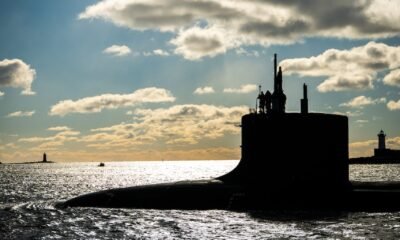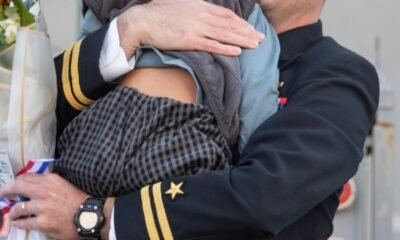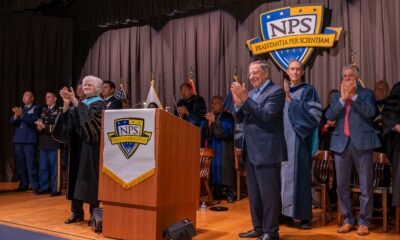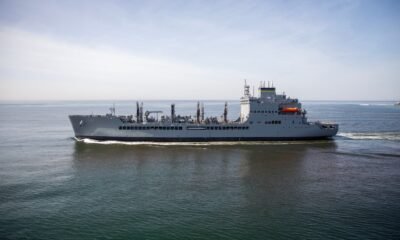Education and Training
NPS Students Revolutionize Fleet Readiness at RIMPAC with Cutting-Edge 3D Printing Technology
MONTEREY, Calif. – Students and faculty from the Naval Postgraduate School (NPS) engaged in innovative advanced manufacturing research during the 2024 Rim of the Pacific (RIMPAC) and Trident Warrior exercises. These activities showcased the potential of new technologies both at sea and on land.
Ten students from the U.S. Navy, Marine Corps, and Army, along with members of the Consortium for Advanced Manufacturing and Research (CAMRE) and FLEETWERX, spent time conducting real-world experiments with cutting-edge additive manufacturing equipment. This equipment created essential repair parts and had tangible impacts.
On the USS Somerset (LPD 25), the CAMRE team included students, Marines from the 3rd Marine Expeditionary Force, the Marine Innovation Unit, and Soldiers from the 25th Infantry Division. Ashore at Marine Corps Base Hawaii, a Joint Advanced Manufacturing Cell (JAMC) focused on leveraging advanced manufacturing for solving readiness challenges.
RIMPAC, concluded earlier this month, allowed students and operators to apply their techniques in realistic training environments. This facilitated a deeper understanding of the importance and practicality of their research in addressing readiness issues.
“At NPS, our primary focus is graduate education,” said Emre Gunduz, Ph.D., an associate professor and CAMRE’s technical director. “Students demonstrated their NPS-derived knowledge in real operational settings, pushing Navy capabilities forward. They could see the immediate relevance of their studies to solving real-world challenges,” he added.
Industry partnerships enabled the use of advanced equipment, such as an expeditionary cold spray printer from XSPEE3D and a hybrid wire directed energy deposition machine from Snowbird Technologies. The latter was installed aboard Somerset, enhancing its additive and subtractive manufacturing capabilities. Additionally, two Advanced Manufacturing Operational System polymer printers were utilized.
“Ship and submarine repair is critical,” said Navy Lt. Cmdr. Zachary Vrtis, an engineering duty officer and mechanical engineering doctorate candidate. “Our goal is to integrate advanced metal manufacturing to supplement traditional methods, expedite repairs, and bolster the submarine industrial base.”
The NPS Advanced Manufacturing Center aids in testing and refining these new techniques. This interdisciplinary facility supports the development of 3D metal printing for defense applications, providing precise and efficient manufacturing solutions.
Marine Corps Lt. Col. Michael Radigan emphasized the importance of pairing top-tier service members with advanced technology to produce real metal parts rapidly. “We demonstrated how to efficiently execute advanced manufacturing to meet defense needs,” he said.
A notable achievement was the repair of a reverse osmosis pump aboard Somerset, preventing an early termination of its participation in the exercise. “The team’s resourcefulness was impressive,” noted Marine Corps Maj. Daniel Szurick, an NPS master’s student. “It reflects a naval culture of resilience and adaptability,” he added.
From an operational standpoint, having the right equipment and expertise on Somerset ensured repairs without affecting mission requirements. This reduced dependence on distant logistics and enhanced overall ship resilience.
Vice Adm. John Wade, commander of U.S. Third Fleet, remarked on the importance of exercises for skill sharpening and real-world experience. “Achieving the exercise’s main objectives required hard work and effective coordination of equipment and training,” he said.
The DOD’s 2021 Additive Manufacturing Strategy aims to operationalize 3D printing capabilities to augment supply chain agility and enhance Navy readiness. These techniques promise significant improvements in operational readiness and self-sufficiency.
“This technology is increasingly game-changing, boosting readiness and self-sufficiency at sea,” said Navy Capt. Jeremy Gray, surface warfare chair at NPS. “Partnerships between the fleet and NPS accelerate experimentation and sailor expertise in advanced techniques,” he added.
Gray works to incorporate advanced manufacturing research aboard ships, thus bridging academic research and practical applications. The efforts of the NPS CAMRE team, alongside others, are key to integrating advanced manufacturing into naval operations.
“CAMRE provides hands-on education to NPS students, fostering talent and advancing technologies for defense,” said CAMRE Director Garth V. Hobson, Ph.D. “We aim to integrate these technologies seamlessly across the Navy, Marine Corps, and joint forces,” he stated.
This research was also supported by U.S. 3rd Fleet, Program Executive Office for Strategic Submarines, the Marine Innovation Unit, and NPS’ Naval Innovation Exchange Additive Manufacturing program.
Located in Monterey, California, NPS offers defense-focused graduate education and interdisciplinary research. Established in 1909, it provides master’s and doctorate programs to Department of Defense personnel and international partners, fostering innovative leaders through advanced academics and research.


















